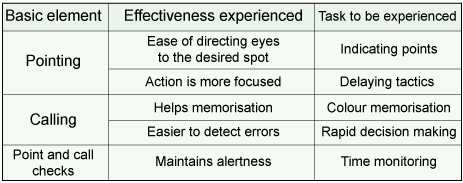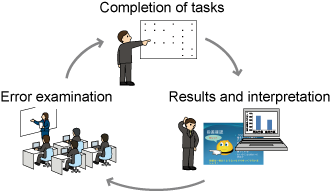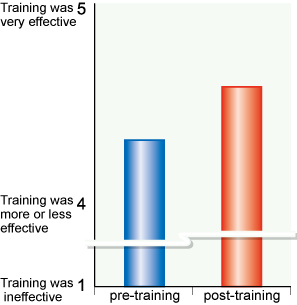2. Understanding the benefits of ‘point-and-call checks’ through experience-based learning
- It has been found that ‘point and call checks’ are effective for preventing human error.
- A software has been developed to teach about the effectiveness of ‘point and call checks’ in reducing human error through experience-based learning.
Point and call checks are used to prevent human error, however, since errors are so rare in practice, it is difficult to grasp its effectiveness and in some cases this customary procedure is even said to have become a dead letter. Thus, a method was developed to instil knowledge about the effectiveness of ‘point and call checks’ in removing human error through experience-based learning.
The first step was to verify the five ‘point and call check’ functions effective in preventing human error (Fig 1). The test involved comparing conditions and checking that the error rate was lower when the ‘point and call check’ was performed as opposed to when it was omitted.
For example, for the task involving acknowledgement of scattered points, in the absence of any accompanying action, the error rate was about 35% whereas it fell to approximately 20% with the ‘point check’. The difference in error rates varied for each task.
The experiential learning software to teach the effectiveness of point and call check s adopted the same set of tasks defined for the verification test mentioned above (Fig 1). The resulting teaching method seeks to instil awareness of the effectiveness of ‘point and call checks’ in preventing human error, on the basis of firsthand error experience and subsequent analysis of the outcome. The trainees were encouraged to reflect on the type of error which could occur in the course of their work before performing the tasks. The test outcome provided them with direct experience of the benefits of ‘point and call checks’. The participants were then asked to think again about the relationship between human error and ‘point and call checks’.
After training using this method, a survey was carried out to determine whether trainees were more aware of the benefits of ‘point and call checks’ through this experience-based learning (Fig 2).
- Table 1 Basic actions in point and call checks, Effectiveness in preventing human error and task to be experienced

 Fig. 1 Experiential training method
Fig. 1 Experiential training method Fig. 2 Perception of effectiveness of the experiential training method
Fig. 2 Perception of effectiveness of the experiential training method